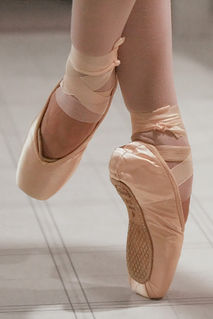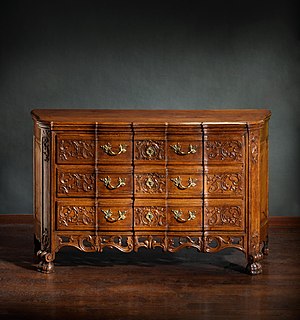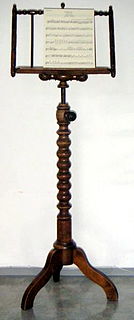
A drawing board is, in its antique form, a kind of multipurpose desk which can be used for any kind of drawing, writing or impromptu sketching on a large sheet of paper or for reading a large format book or other oversized document or for drafting precise technical illustrations. The drawing table used to be a frequent companion to a pedestal desk in a gentleman's study or private library, during the pre-industrial and early industrial era.

A sink — also known by other names including sinker, washbowl, hand basin, and wash basin—is a bowl-shaped plumbing fixture used for washing hands, dishwashing, and other purposes. Sinks have taps (faucets) that supply hot and cold water and may include a spray feature to be used for faster rinsing. They also include a drain to remove used water; this drain may itself include a strainer and/or shut-off device and an overflow-prevention device. Sinks may also have an integrated soap dispenser. Many sinks, especially in kitchens, are installed adjacent to or inside a counter.
Eton Fives, a derivative of the British game of fives, is a handball game, similar to Rugby Fives, played as doubles in a three-sided court. The object is to force the other team to fail to hit the ball 'up' off the front wall, using any variety of wall or ledge combinations as long as the ball is played 'up' before it bounces twice. Eton Fives is an uncommon sport, with only a few courts, most of them as part of the facilities of the independent schools in the United Kingdom. Public school Rydal Penrhos currently enjoys the only Eton Fives courts in Wales.

A desk or bureau is a piece of furniture with a flat table-style work surface used in a school, office, home or the like for academic, professional or domestic activities such as reading, writing, or using equipment such as a computer. Desks often have one or more drawers, compartments, or pigeonholes to store items such as office supplies and papers. Desks are usually made of wood or metal, although materials such as glass are sometimes seen.
A secretary desk or escritoire is made of a base of wide drawers topped by a desk with a hinged desktop surface, which is in turn topped by a bookcase usually closed with a pair of doors, often made of glass. The whole is usually a single, tall and heavy piece of furniture.

The fall front desk can be considered the cousin of the secretary desk. Both have a main working surface or desktop which does double duty as a cover to seal up papers and other items located in small shelves or small drawers placed one on top of the other in front of the user. Thus, all working papers, documents and other items have to be stored before the desk is closed.
The Wooton desk is a variation of the fall front desk.
There are two kinds of trestle desks, the antique form and the modern improvisation.

A standing desk or stand-up desk is a desk conceived for writing or reading while standing up or while sitting on a high stool.

In cabinetry, the bargueño is a form of portable desk, made up of two chests, the bottom one usually having drawers and the top one having a hinged desk surface which also serves as a side mounted lid. It is basically a chest or box with one of the side panels, rather than the top panel, serving as a fold-out writing surface. The interior of the desk is equipped with small drawers, pigeonholes, etc., for storing papers and supplies. The bargueño has also been used for sewing or as a jewel chest.

A pointe shoe is a type of shoe worn by ballet dancers when performing pointe work. Pointe shoes were conceived in response to the desire for dancers to appear weightless and sylph-like and have evolved to enable dancers to dance en pointe for extended periods of time. They are manufactured in a variety of colors, from darker nudes, to most commonly in shades of light pink.

A chest is a form of furniture typically of a rectangular structure with four walls and a removable lid, for storage. The interior space may be subdivided. The early uses of an antique chest or coffer included storage of fine cloth, weapons, foods and valuable items. It is a box with a hinged lid that can safeguard your personal items. Some chests are equipped with locking mechanisms or a metal band that a lock can be secured on. In Webster’s Dictionary 1988 version, a chest is defined as a “a box with a lid and often, a lock, for storing or shipping things” or as “a cabinet as for holding medical supplies, toiletries, etc.”

A chest of drawers, also called a drawers table or a bureau, is a type of cabinet that has multiple parallel, horizontal drawers usually stacked one above another.

Equine conformation evaluates the degree of correctness of a horse's bone structure, musculature, and its body proportions in relation to each other. Undesirable conformation can limit the ability to perform a specific task. Although there are several faults with universal disadvantages, a horse's conformation is usually judged by what its intended use may be. Thus "form to function" is one of the first set of traits considered in judging conformation. A horse with poor form for a Grand Prix show jumper could have excellent conformation for a World Champion cutting horse, or to be a champion draft horse. Every horse has good and bad points of its conformation and many horses excel even with conformation faults.

A kickstand is a device on a bicycle or motorcycle that allows the bike to be kept upright without leaning against another object or the aid of a person. A kickstand is usually a piece of metal that flips down from the frame and makes contact with the ground. It is generally located in the middle of the bike or towards the rear. Some touring bicycles have two: one at the rear, and a second in the front.

A drawer is a box-shaped container that fits into a piece of furniture in such a way that it can be drawn out horizontally to reach its contents. Drawers are built into numerous types of furniture, including cabinets, chests of drawers (bureaus) and the like.

A caster board or vigorboard is a two-wheeled, human-powered land vehicle. It is not a skateboard. Other names are waveboard "J-board" and RipStik, both of which are derived from commercial brands.

A music stand is a pedestal or elevated rack designed to hold a paper score or sheets of music in position for reading. Most music stands for orchestral, chamber music or solo orchestra-family instruments can be raised or lowered to accommodate seated or standing performers, or performers of different heights. Many types of keyboard instruments have a built-in or removable music rack or stand where sheet music can be placed. Music stands enable musicians to read sheet music or scores while playing an instrument or conducting, as the stand leaves the hands free. Music stands are sometimes used by singers, however for choirs, singers typically hold their sheet music in a folder, and singers performing solo recitals or opera performances typically memorize the lyrics and melodies. Some singers use stands, such as lounge singers and wedding vocalists who have a repertoire of hundreds of songs, which makes remembering all of the verses difficult.

A cabinet is a box-shaped piece of furniture with doors and/or drawers for storing miscellaneous items. Some cabinets stand alone while others are built in to a wall or are attached to it like a medicine cabinet. Cabinets are typically made of wood, coated steel, or synthetic materials. Commercial grade cabinets, which differ in the materials used, are called casework, casegoods, or case furniture.
The Acadia Plantation was a historic plantation house in Thibodaux, Louisiana, U.S.. It was the plantation of James Bowie, Rezin P. Bowie, and Stephen Bowie. James "Jim" Bowie, served in the Battle of the Alamo. It was listed on the National Register of Historic Places on May 29, 1987. It was demolished in 2010.














